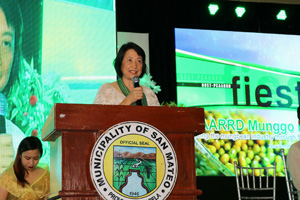
The country’s mungbean production falls short of its annual domestic requirement with a self-sufficiency ratio of only about 52%.
This was explained by Dr. Melvin B. Carlos, OIC Deputy for Administration, Resource Management and Support Services (ARMSS) of the Philippine Council for Agriculture, Aquatic and Natural Resources Research and Development of the Department of Science and Technology (DOST-PCAARRD). Dr. Carlos’s message was delivered for him by Marita A. Carlos, Director of the Applied Communication Division (ACD) of PCAARRD during the Mungbean Farms and Industry Encounters through the Science and Technology Agenda (FIESTA).
Held in San Mateo, Isabela, which is regarded as the Mungbean Capital of the Philippines, the event was spearheaded by the Cagayan Valley Agriculture, Aquatic and Natural Resources Research and Development (CVAARRD) Consortium.
Carlos said that the country is dependent on imports mainly from Myanmar, China, Indonesia and Thailand to fill in the gap of our annual domestic requirement of around 65,000 mt.
Carlos attributed low mungbean production to certain concerns such as shortage of quality seeds of improved and adaptable varieties, absence of seed support system, and farmers’ lack of technical knowledge and skills.
Faced by these constraints, Carlos said that DOST-PCAARRD, in partnership with the Department of Agriculture, state colleges and universities like Pampanga State Agricultural University (PSAU), other national and local government and private institutions, came up with the Mungbean Industry Strategic S&T Program (ISP) to support the ailing industry.
According to Carlos, among the S&T interventions seen as necessary to support the industry were the development, promotion, and distribution of improved varieties; organization and accreditation of farmer-seed growers; establishment of techno-demo farms; development of integrated pest management strategy, and development of new products derived from mungbean.
Identified as the focus of these S&T interventions under the Mungbean ISP are the four major mungbean producing regions (Region II, Cagayan Valley; Region lll, Central Luzon; Region Vl, Western Visayas; and Region Xl, Davao Region).
The goal is to increase the volume of quality seeds for planting, additional and expansion areas for new and improved varieties; implementing mungbean package of technology (POT); and increasing national average yield from 0.72 mt/ha to 1.0 mt/ha.
The Mungbean FIESTA was graced by San Mateo Municipal Mayor Crispina R. Agcaoili, Vice Mayor Roberto C. Agcaoili, Isabela State University President Dr. Ricmar P. Aquino, DOST ll Regional Director Engr. Sancho A. Maborang, CVAARRD Consortium Director Dr. William C. Medrano, and Director Marita A. Carlos of the Applied Communication Division, DOST-PCAARRD. Other participants included LGU officials, researchers, farmers, students, media partners, and the general public.
